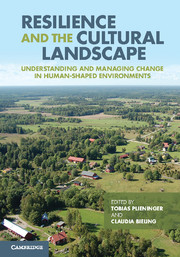 Resilience and the Cultural Landscape
Resilience and the Cultural Landscape Book contents
- Frontmatter
- Contents
- List of contributors
- Preface
- Part I Conceptualising landscapes as social–ecological systems
- Part II Analysing landscape resilience
- 7 In search of resilient behaviour: using the driving forces framework to study cultural landscapes
- 8 Cultural landscapes as complex adaptive systems: the cases of northern Spain and northern Argentina
- 9 Linking path dependency and resilience for the analysis of landscape development
- 10 The sugar-cane landscape of the Caribbean islands: resilience, adaptation and transformation of the plantation social–ecological system
- 11 Offshore wind farming on Germany’s North Sea coast: tracing regime shifts across scales
- Part III Managing landscapes for resilience
- Part IV Perspectives for resilient landscapes
- Index
- References
7 - In search of resilient behaviour: using the driving forces framework to study cultural landscapes
Published online by Cambridge University Press: 05 November 2012
- Frontmatter
- Contents
- List of contributors
- Preface
- Part I Conceptualising landscapes as social–ecological systems
- Part II Analysing landscape resilience
- 7 In search of resilient behaviour: using the driving forces framework to study cultural landscapes
- 8 Cultural landscapes as complex adaptive systems: the cases of northern Spain and northern Argentina
- 9 Linking path dependency and resilience for the analysis of landscape development
- 10 The sugar-cane landscape of the Caribbean islands: resilience, adaptation and transformation of the plantation social–ecological system
- 11 Offshore wind farming on Germany’s North Sea coast: tracing regime shifts across scales
- Part III Managing landscapes for resilience
- Part IV Perspectives for resilient landscapes
- Index
- References
Summary
Introduction
Cultural landscapes are shaped by society and nature alike. As societies and nature are dynamic, change is an inherent characteristic of cultural landscapes. Understanding these changes is one of the prime goals of the recently emerged field of land change science (Turner et al., 2007; Turner & Robbins, 2008). Although a unifying theory of land change does not yet exist, significant theoretical advances have been made (Briassoulis, 2000; Lambin et al., 2006; Walker & Solecki, 2004).
Studies of landscape change increasingly go beyond a merely descriptive approach and adopt an analytical perspective. In the context of the topics presented in this book, this means that challenging questions like ‘Why does a certain landscape show traits of resilient behaviour in regard to certain aspects and over a defined period?’ are addressed. One way of meeting this challenge is to systematically study the landscape changes and the factors responsible for the observed change and persistency. These so-called driving forces of landscape change (Bürgi et al., 2004) can be analysed for all kinds of cultural or natural landscapes.
Both terms, cultural landscapes and resilience, have a normative character. The term resilience is usually positively used, but resilient behaviour of landscapes is not desirable per se (Cumming, 2011). For example, a land manager trying in vain to restore a degraded cultural landscape will perceive resilience of this landscape as problematic. The term cultural landscape is partly value-laden in quite a similar way. On the one hand, all landscapes that are shaped by anthropogenic activities can be called cultural landscapes, many of which underwent radical changes in the last decades. In these cases, no specific positive connotation of the term cultural landscapes is intended.
- Type
- Chapter
- Information
- Resilience and the Cultural LandscapeUnderstanding and Managing Change in Human-Shaped Environments, pp. 113 - 125Publisher: Cambridge University PressPrint publication year: 2012
References
- 1
- Cited by


